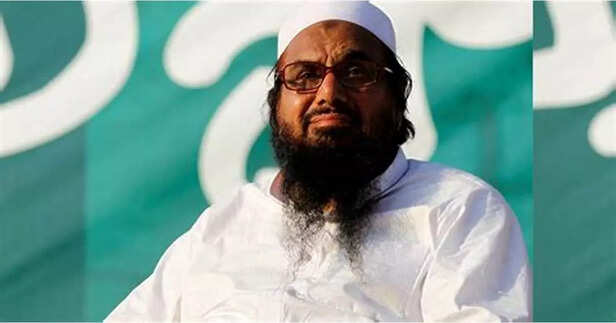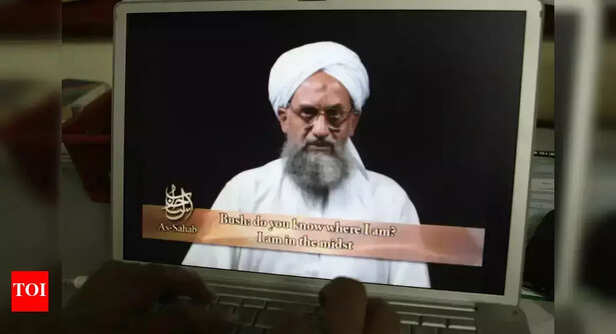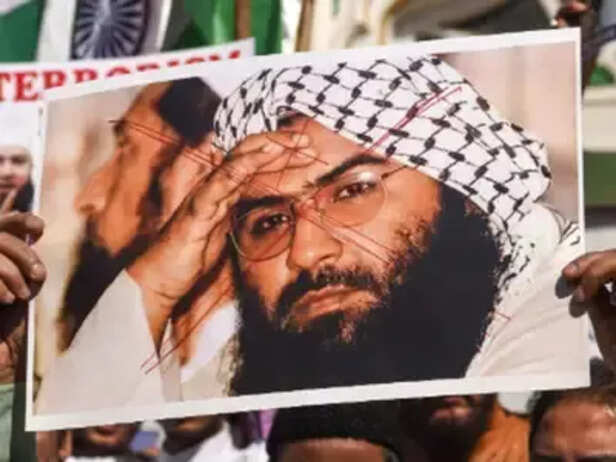6 Terrorists Who Were Found in Pakistan
Nidhi | May 14, 2025, 18:02 IST

( Image credit : Times Life Bureau )
Behind Pakistan’s battle with terrorism lies a troubling reality: some of the world’s most dangerous terrorists have been found hiding within its borders. From Osama bin Laden to Hafiz Saeed, discover the stories of six notorious figures linked to major attacks. This article explores the unsettling questions raised by their sheltering in Pakistan and what it means for global security.
For decades, Pakistan has faced the dual challenge of being both a victim and a suspected shelter for global terrorism. With over 80,000 Pakistanis losing their lives to terror-related violence since 2001, the country has paid a heavy price. Yet, despite its own struggles, Pakistan has been repeatedly linked to the presence of high-profile terrorists. Figures like Osama bin Laden, mastermind of the 9/11 attacks, and Hafiz Saeed, the architect behind the 2008 Mumbai attacks, were found operating from within its borders, raising difficult questions.
How is it possible that such figures — responsible for some of the deadliest attacks in history — have been able to live, operate, and sometimes even preach openly in Pakistan? Is this negligence, or does it reflect a more complex reality? In this article, we explore six notorious terrorists who were found in Pakistan, their activities, and the impact their sheltering has had on both Pakistan and the world.
al-Qaeda Leader | Killed in Abbottabad, 2011
Key Attacks Linked:
9/11 Attacks (2001) – Nearly 3,000 deaths in the U.S.
U.S. Embassy Bombings (1998) in Kenya and Tanzania
9/11 Attacks (2001) – Nearly 3,000 deaths in the U.S.
U.S. Embassy Bombings (1998) in Kenya and Tanzania
Found: Hiding in Abbottabad, a military garrison town, less than a mile from Pakistan’s premier military academy.
Killed in: Operation Neptune Spear, a U.S. Navy SEAL raid carried out without Pakistani consent in May 2011.
The discovery of the world’s most wanted terrorist in a fortified compound in Pakistan not only embarrassed the Pakistani military establishment but also fueled global suspicion of silent support or strategic blindness.
Pakistan denied knowledge of his presence, but the question remains: How does a man who changed the course of global history live undetected for years so close to Pakistan’s military core? 
Founder of Lashkar-e-Taiba (LeT) | Lived and preached openly in Lahore
Key Attacks Linked:
26/11 Mumbai Attacks (2008) – 166 killed, including foreign nationals
2006 Varanasi Bombings
2006 Mumbai Train Blasts 26/11 Mumbai Attacks (2008) – 166 killed, including foreign nationals
2006 Varanasi Bombings
2006 Mumbai Train Blasts Group Fronts: Jamaat-ud-Dawa (JuD), Falah-e-Insaniyat Foundation — both alleged charity fronts for LeT.
Pakistan’s Response:
Repeated house arrests under pressure.
Convicted in 2020 for terror financing, days before an FATF review.
Repeated house arrests under pressure.
Convicted in 2020 for terror financing, days before an FATF review.
Despite a $10 million U.S. bounty, Saeed led public rallies, gave sermons, and even appeared in media interviews — reinforcing the idea that international designations don’t always translate into local accountability.
Even after his conviction, critics note that Pakistan acted only under threat of economic sanctions, not out of intrinsic policy change. 
al-Qaeda’s Ideologue and Leader | Allegedly sheltered in Pakistan for over a decade
Key Attacks Linked:
9/11 (2001) – Co-planner with bin Laden USS Cole Bombing (2000) Multiple al-Qaeda-led attacks in Yemen and Somalia
9/11 (2001) – Co-planner with bin Laden USS Cole Bombing (2000) Multiple al-Qaeda-led attacks in Yemen and Somalia
Presence in Pakistan:
U.S. intelligence tracked him to Pakistan’s tribal areas (North Waziristan, Bajaur) through the 2000s.
He evaded the CIA drone campaign that killed several other top al-Qaeda figures in the region. U.S. intelligence tracked him to Pakistan’s tribal areas (North Waziristan, Bajaur) through the 2000s.
He evaded the CIA drone campaign that killed several other top al-Qaeda figures in the region. Killed in: 2022 U.S. drone strike in Kabul, raising suspicions that he had support throughout the region. Zawahiri was more than a fugitive; he was the ideological architect of al-Qaeda's transnational vision. His extended survival despite drone surveillance underscores how safe zones for such leaders can persist under local protection — or quiet complicity 
Founder of Jaish-e-Mohammed (JeM) | Based in Bahawalpur
Key Attacks Linked:
2001 Indian Parliament Attack 2016 Pathankot Airbase Attack
2019 Pulwama Suicide Bombing – 40 Indian paramilitary personnel killed
2001 Indian Parliament Attack 2016 Pathankot Airbase Attack
2019 Pulwama Suicide Bombing – 40 Indian paramilitary personnel killed
Released by India in 1999 during the IC-814 hijacking after a hostage swap.
Designated a global terrorist by the UN in 2019 after years of opposition — largely by China at Pakistan’s behest.
Pakistan's Stand: Despite multiple dossiers, Pakistan claimed it couldn’t locate him — even as his group continued public activity.
Azhar’s existence and influence in Pakistan go beyond hiding — he ran religious seminaries and armed cadres, making Bahawalpur a known hub of extremist indoctrination.
Pakistan launched Operation Radd-ul-Fasaad (2017) to neutralize terror infrastructure — but JeM-linked groups have remained notably persistent.
Underworld Don | 1993 Bombay Bombings Mastermind | Based in Karachi
Key Attacks Linked:
1993 Bombay Serial Blasts – 257 killed, over 700 injured Funding and facilitating terror operations in India through D-Company
Narco-terrorism and arms smuggling
1993 Bombay Serial Blasts – 257 killed, over 700 injured Funding and facilitating terror operations in India through D-Company
Narco-terrorism and arms smuggling
Global Sanctions:
Designated by India, U.S., UK, and UN as a terrorist
U.S. Treasury listed several Karachi-based properties as his assets
Designated by India, U.S., UK, and UN as a terrorist
U.S. Treasury listed several Karachi-based properties as his assets
Pakistan’s Response: Denial of his presence — despite evidence in real estate documents, telephone records, and intelligence reports. Ibrahim’s case exposes the nexus between crime and ideological terrorism, where mafia-style funding and global jihad intersect — often under unofficial protection.
His influence extends into Dubai, Malaysia, and Africa — but his alleged Karachi base remains one of the worst-kept secrets in international counterterrorism. 
Taliban Founder | Reportedly died in Karachi, 2013
Key Attacks Linked:
Oversaw Taliban rule from 1996–2001 and its post-2001 insurgency
Provided safe haven to bin Laden
Insurgent attacks against NATO and Afghan forces during the U.S. occupation
Oversaw Taliban rule from 1996–2001 and its post-2001 insurgency
Provided safe haven to bin Laden
Insurgent attacks against NATO and Afghan forces during the U.S. occupation
Death Mystery:
Taliban claimed he died in Afghanistan
Afghan intelligence claimed he died in Karachi’s hospital in 2013
Taliban claimed he died in Afghanistan
Afghan intelligence claimed he died in Karachi’s hospital in 2013
Posthumous Relevance:
His movement morphed into the Afghan Taliban 2.0, now in power in Kabul.
The Quetta Shura (senior Taliban leadership council) is widely believed to have operated from Pakistan during the insurgency.
His movement morphed into the Afghan Taliban 2.0, now in power in Kabul.
The Quetta Shura (senior Taliban leadership council) is widely believed to have operated from Pakistan during the insurgency.
Omar symbolizes the resilience of ideological sanctuaries, where insurgent leaders shift identities but not locations — often blending in with local networks under state radar. Pakistan has conducted ambitious counterterror operations — Zarb-e-Azb (2014) dismantled militant havens in North Waziristan; Radd-ul-Fasaad (2017) aimed at eliminating extremism nationwide. But critics argue these campaigns selectively target anti-Pakistan groups while tolerating or ignoring those used as "strategic assets" in regional conflicts.
The terrorists listed here were not minor players — they shaped entire global narratives, cost thousands of lives, and disrupted nations. That they were found in Pakistan — repeatedly, and often openly — is not merely a coincidence.
So the question that remains is not whether Pakistan has terrorists — but why so many of the world’s most wanted ones seem to end up there.
How is it possible that such figures — responsible for some of the deadliest attacks in history — have been able to live, operate, and sometimes even preach openly in Pakistan? Is this negligence, or does it reflect a more complex reality? In this article, we explore six notorious terrorists who were found in Pakistan, their activities, and the impact their sheltering has had on both Pakistan and the world.
1. Osama bin Laden
Key Attacks Linked:
9/11 Attacks (2001) – Nearly 3,000 deaths in the U.S.
U.S. Embassy Bombings (1998) in Kenya and Tanzania
9/11 Attacks (2001) – Nearly 3,000 deaths in the U.S.
U.S. Embassy Bombings (1998) in Kenya and Tanzania
Found: Hiding in Abbottabad, a military garrison town, less than a mile from Pakistan’s premier military academy.
Killed in: Operation Neptune Spear, a U.S. Navy SEAL raid carried out without Pakistani consent in May 2011.
The discovery of the world’s most wanted terrorist in a fortified compound in Pakistan not only embarrassed the Pakistani military establishment but also fueled global suspicion of silent support or strategic blindness.
Pakistan denied knowledge of his presence, but the question remains: How does a man who changed the course of global history live undetected for years so close to Pakistan’s military core?
2. Hafiz Saeed

Hafiz Saeed
( Image credit : Times Life Bureau )
Founder of Lashkar-e-Taiba (LeT) | Lived and preached openly in Lahore
Key Attacks Linked:
26/11 Mumbai Attacks (2008) – 166 killed, including foreign nationals
2006 Varanasi Bombings
2006 Mumbai Train Blasts 26/11 Mumbai Attacks (2008) – 166 killed, including foreign nationals
2006 Varanasi Bombings
2006 Mumbai Train Blasts Group Fronts: Jamaat-ud-Dawa (JuD), Falah-e-Insaniyat Foundation — both alleged charity fronts for LeT.
Pakistan’s Response:
Repeated house arrests under pressure.
Convicted in 2020 for terror financing, days before an FATF review.
Repeated house arrests under pressure.
Convicted in 2020 for terror financing, days before an FATF review.
Despite a $10 million U.S. bounty, Saeed led public rallies, gave sermons, and even appeared in media interviews — reinforcing the idea that international designations don’t always translate into local accountability.
Even after his conviction, critics note that Pakistan acted only under threat of economic sanctions, not out of intrinsic policy change.
3. Ayman al-Zawahiri

Ayman al-Zawahiri
( Image credit : Times Life Bureau )
al-Qaeda’s Ideologue and Leader | Allegedly sheltered in Pakistan for over a decade
Key Attacks Linked:
9/11 (2001) – Co-planner with bin Laden USS Cole Bombing (2000) Multiple al-Qaeda-led attacks in Yemen and Somalia
9/11 (2001) – Co-planner with bin Laden USS Cole Bombing (2000) Multiple al-Qaeda-led attacks in Yemen and Somalia
Presence in Pakistan:
U.S. intelligence tracked him to Pakistan’s tribal areas (North Waziristan, Bajaur) through the 2000s.
He evaded the CIA drone campaign that killed several other top al-Qaeda figures in the region. U.S. intelligence tracked him to Pakistan’s tribal areas (North Waziristan, Bajaur) through the 2000s.
He evaded the CIA drone campaign that killed several other top al-Qaeda figures in the region. Killed in: 2022 U.S. drone strike in Kabul, raising suspicions that he had support throughout the region. Zawahiri was more than a fugitive; he was the ideological architect of al-Qaeda's transnational vision. His extended survival despite drone surveillance underscores how safe zones for such leaders can persist under local protection — or quiet complicity
4. Masood Azhar

Masood Azhar
( Image credit : Times Life Bureau )
Founder of Jaish-e-Mohammed (JeM) | Based in Bahawalpur
Key Attacks Linked:
2001 Indian Parliament Attack 2016 Pathankot Airbase Attack
2019 Pulwama Suicide Bombing – 40 Indian paramilitary personnel killed
2001 Indian Parliament Attack 2016 Pathankot Airbase Attack
2019 Pulwama Suicide Bombing – 40 Indian paramilitary personnel killed
Released by India in 1999 during the IC-814 hijacking after a hostage swap.
Designated a global terrorist by the UN in 2019 after years of opposition — largely by China at Pakistan’s behest.
Pakistan's Stand: Despite multiple dossiers, Pakistan claimed it couldn’t locate him — even as his group continued public activity.
Azhar’s existence and influence in Pakistan go beyond hiding — he ran religious seminaries and armed cadres, making Bahawalpur a known hub of extremist indoctrination.
Pakistan launched Operation Radd-ul-Fasaad (2017) to neutralize terror infrastructure — but JeM-linked groups have remained notably persistent.
5. Dawood Ibrahim
Key Attacks Linked:
1993 Bombay Serial Blasts – 257 killed, over 700 injured Funding and facilitating terror operations in India through D-Company
Narco-terrorism and arms smuggling
1993 Bombay Serial Blasts – 257 killed, over 700 injured Funding and facilitating terror operations in India through D-Company
Narco-terrorism and arms smuggling
Global Sanctions:
Designated by India, U.S., UK, and UN as a terrorist
U.S. Treasury listed several Karachi-based properties as his assets
Designated by India, U.S., UK, and UN as a terrorist
U.S. Treasury listed several Karachi-based properties as his assets
Pakistan’s Response: Denial of his presence — despite evidence in real estate documents, telephone records, and intelligence reports. Ibrahim’s case exposes the nexus between crime and ideological terrorism, where mafia-style funding and global jihad intersect — often under unofficial protection.
His influence extends into Dubai, Malaysia, and Africa — but his alleged Karachi base remains one of the worst-kept secrets in international counterterrorism.
6. Mullah Mohammad Omar

Mullah Mohammad Omar
( Image credit : Times Life Bureau )
Taliban Founder | Reportedly died in Karachi, 2013
Key Attacks Linked:
Oversaw Taliban rule from 1996–2001 and its post-2001 insurgency
Provided safe haven to bin Laden
Insurgent attacks against NATO and Afghan forces during the U.S. occupation
Oversaw Taliban rule from 1996–2001 and its post-2001 insurgency
Provided safe haven to bin Laden
Insurgent attacks against NATO and Afghan forces during the U.S. occupation
Death Mystery:
Taliban claimed he died in Afghanistan
Afghan intelligence claimed he died in Karachi’s hospital in 2013
Taliban claimed he died in Afghanistan
Afghan intelligence claimed he died in Karachi’s hospital in 2013
Posthumous Relevance:
His movement morphed into the Afghan Taliban 2.0, now in power in Kabul.
The Quetta Shura (senior Taliban leadership council) is widely believed to have operated from Pakistan during the insurgency.
His movement morphed into the Afghan Taliban 2.0, now in power in Kabul.
The Quetta Shura (senior Taliban leadership council) is widely believed to have operated from Pakistan during the insurgency.
Omar symbolizes the resilience of ideological sanctuaries, where insurgent leaders shift identities but not locations — often blending in with local networks under state radar.
Are These Just Coincidences — or Consequences of Policy?
The terrorists listed here were not minor players — they shaped entire global narratives, cost thousands of lives, and disrupted nations. That they were found in Pakistan — repeatedly, and often openly — is not merely a coincidence.
So the question that remains is not whether Pakistan has terrorists — but why so many of the world’s most wanted ones seem to end up there.
